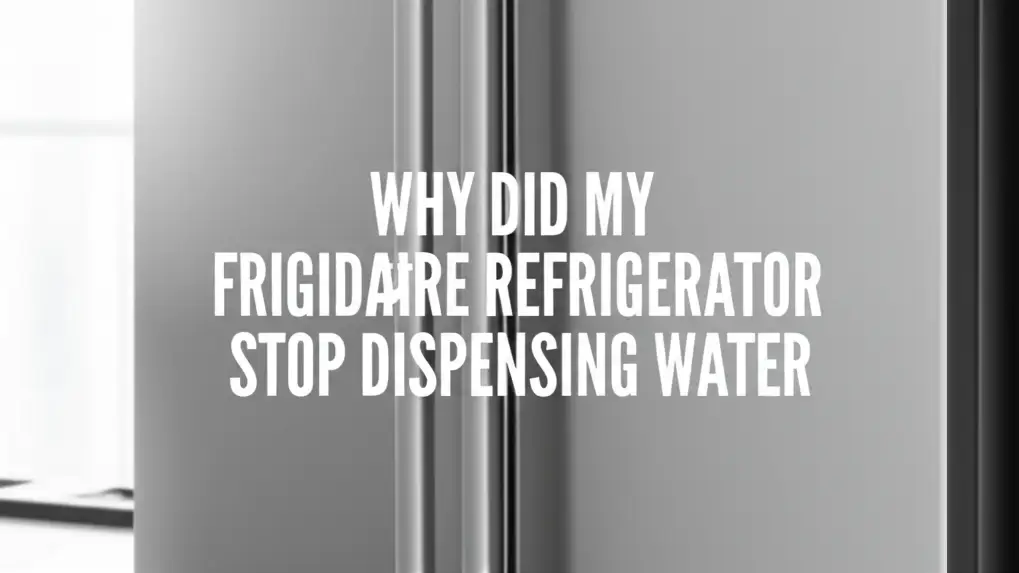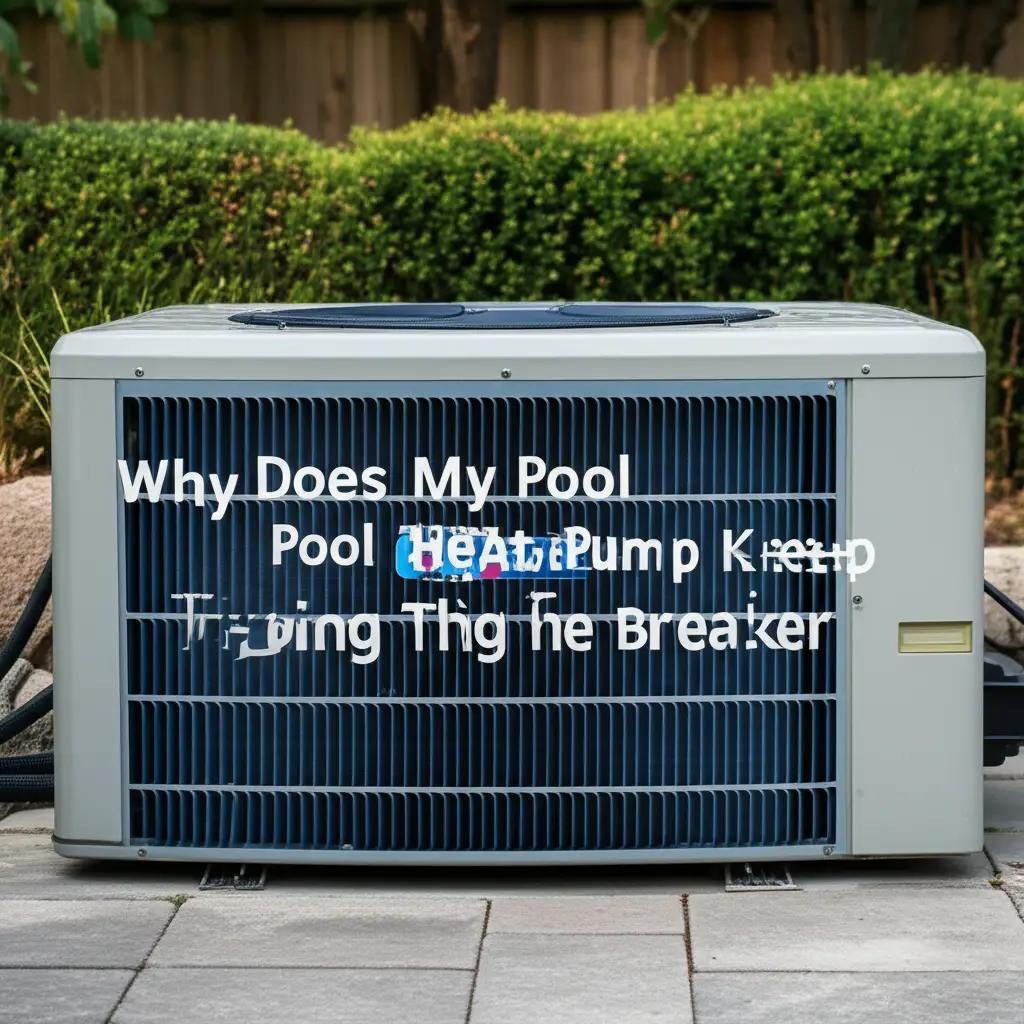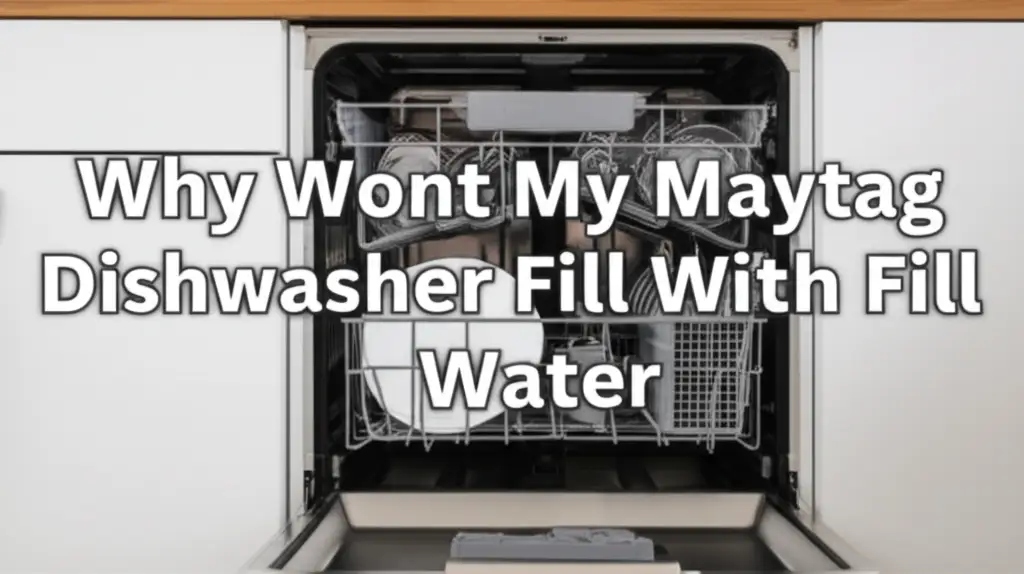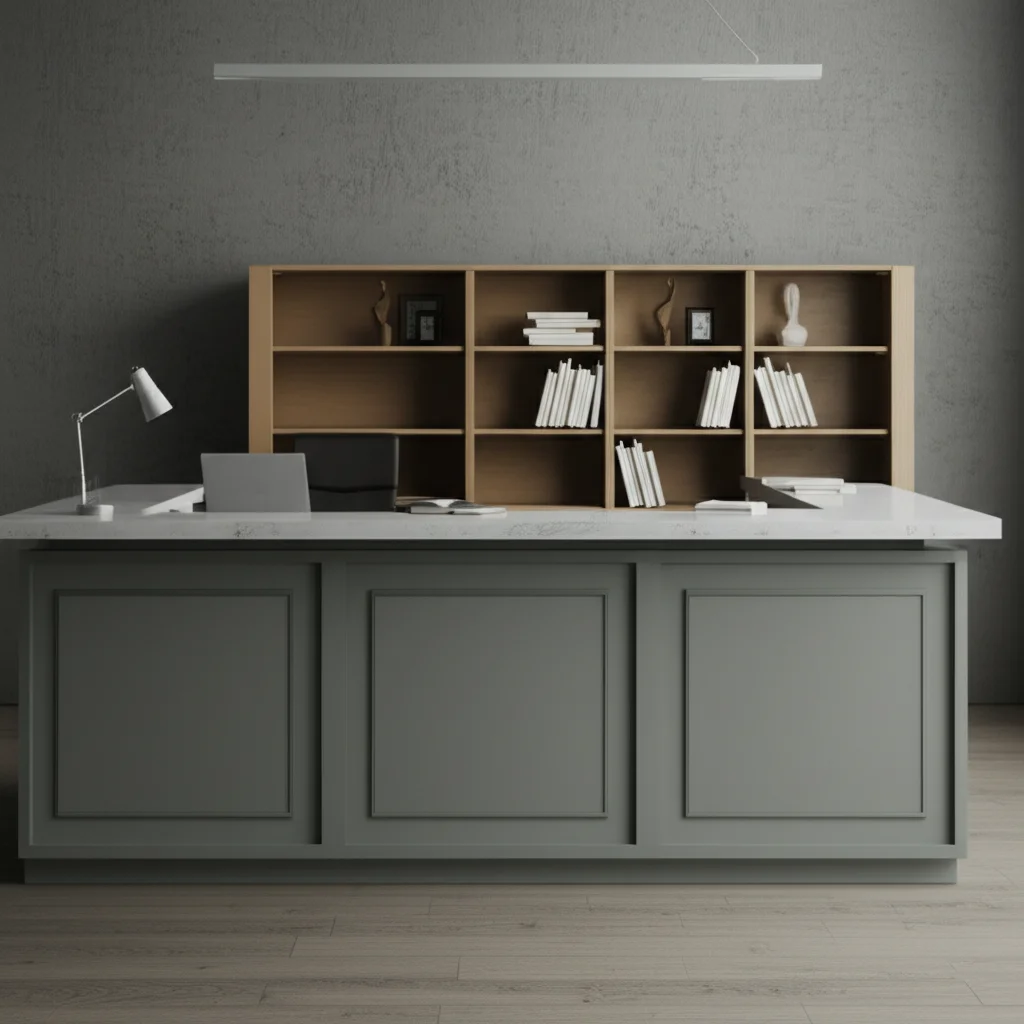· Todd Martin · Home Improvement · 20 min read
Why Did My Frigidaire Refrigerator Stop Dispensing Water

Frigidaire Water Dispenser Not Working? Here’s Why
Imagine walking into your kitchen on a hot day, ready for a refreshing glass of cold water. You press the lever on your Frigidaire refrigerator, but nothing happens. No water comes out. This can be frustrating, especially when you rely on your appliance daily. I know this feeling well.
A non-dispensing Frigidaire refrigerator is a common issue many homeowners face. There are several reasons your water dispenser might suddenly stop working. Pinpointing the exact cause helps you fix the problem quickly. We will explore the most frequent culprits behind a Frigidaire water dispenser malfunction. This guide will walk you through easy troubleshooting steps. You can identify the problem and get your water flowing again.
Takeaway
- Check the Water Filter: An old or clogged filter is the most common reason for no water.
- Inspect Water Lines: Look for kinks or frozen sections in the water supply lines.
- Verify Water Supply: Ensure the household water supply valve is fully open.
- Examine Dispenser Components: Test the dispenser lever, door switch, and water inlet valve.
- Consider Professional Help: If simple fixes do not work, a professional technician can diagnose complex issues.
Why Did My Frigidaire Refrigerator Stop Dispensing Water?
Your Frigidaire refrigerator stopped dispensing water likely due to a clogged water filter, a frozen water supply line, a faulty water inlet valve, or an engaged child lock. Other reasons include low water pressure, a malfunctioning dispenser switch, or a problem with the refrigerator’s door switch.
Understanding Your Frigidaire’s Water System
Your Frigidaire refrigerator uses a basic system to give you cold water. First, water comes from your home’s main supply line. This water enters the refrigerator through a small tube. It passes through a filter to remove impurities. The filtered water then moves to a holding tank, often chilled. When you press the dispenser paddle, a signal goes to a valve. This valve opens, allowing water to flow out through the dispenser nozzle.
This system relies on several parts working correctly. If any part fails, your water dispenser stops working. Knowing how the system works helps you troubleshoot. We will look at each part in detail. This allows you to find where the water flow breaks.
Water Supply and Pressure
The journey of water begins outside your refrigerator. A small water line connects to your home’s main water supply. This line has a shut-off valve. If this valve is closed, no water reaches the refrigerator. Ensure the valve is fully open. Also, your home needs enough water pressure. Low water pressure prevents the dispenser from working. Many refrigerators need at least 20 PSI of water pressure. This ensures proper water flow and operation. Check if other water fixtures in your home have good pressure. If they do not, the issue might be with your home’s main water supply.
The Role of the Water Filter
A key component in your Frigidaire’s water system is the water filter. This filter cleans the water before you drink it. It removes sediment, chlorine, and other contaminants. Over time, the filter collects these particles. This causes it to become clogged. A clogged filter restricts water flow. Eventually, it can stop water flow completely. Frigidaire recommends changing filters every six months. Ignoring this can lead to your dispenser stopping. A new filter often solves the problem.
Internal Components: Valve, Lines, and Switches
Inside the refrigerator, a water inlet valve controls water entry. This valve opens when electricity flows to it. It closes when the dispenser is not active. If the valve fails, water cannot enter the system. Flexible water lines carry water through the appliance. These lines can sometimes kink or freeze. Lastly, small switches tell the dispenser when to activate. The door switch tells the refrigerator if the door is open or closed. If it thinks the door is open, it will not dispense water. The dispenser paddle also has a switch. If this switch breaks, pressing the paddle does nothing.
Is Your Frigidaire Water Filter Clogged or Expired?
A clogged or expired water filter is the most common reason your Frigidaire refrigerator stops dispensing water. I have seen this issue many times. Filters are designed to trap impurities. Over time, they become saturated with these particles. This blockage reduces water flow to a trickle, or stops it completely. Frigidaire generally recommends replacing your water filter every six months. This period ensures optimal water quality and dispenser performance. Ignoring this replacement schedule almost guarantees a problem.
Your refrigerator often has an indicator light for the water filter. When this light turns red, it means the filter needs replacement. Do not wait for the water flow to stop completely. Replacing the filter proactively helps maintain a steady water supply. A new filter can often bring your dispenser back to life. It is a simple fix that you can do yourself.
How to Check and Replace Your Water Filter
Checking your water filter is an easy first step. Most Frigidaire filters are located in the upper right corner of the fresh food compartment. Some are in the base grille at the bottom. Consult your owner’s manual if you are unsure of the location. Once you locate it, remove the old filter. Try to dispense water without the filter in place. If water flows freely, you have found your problem.
Replacing the filter is straightforward. Purchase a genuine Frigidaire replacement filter. Generic filters may not fit correctly or filter as effectively. Twist the old filter counter-clockwise to remove it. Push the new filter in and twist it clockwise until it locks. After installation, flush the system. Dispense several gallons of water to remove air and carbon particles from the new filter. This ensures clean water and prevents air lock issues. If your GE refrigerator stopped dispensing water after a filter change, the same flushing steps apply. You can learn more about general filter-related issues here: Why is my GE Refrigerator Not Dispensing Water After Replacing Filter?.
Signs of a Clogged Filter Beyond No Water
Besides no water, other signs point to a clogged filter. You might notice a significant decrease in water pressure. The water stream may be very slow. The taste and smell of the water can also change. If your water starts tasting or smelling bad, it is a clear sign the filter is no longer doing its job. You might also notice small black carbon particles in your dispensed water. This indicates the filter media is breaking down. Addressing these signs quickly prevents complete water stoppage. Regular filter replacement saves you hassle. For issues specific to leaks around filters, consider reading Why is my Frigidaire Refrigerator Leaking Water From the Filter?.
Frozen Water Line: A Common Frigidaire Dispenser Problem
A common reason your Frigidaire refrigerator stops dispensing water is a frozen water line. This happens more often than you might think. Water lines inside the freezer section can freeze up. This blockage prevents water from reaching the dispenser. It often occurs if the freezer temperature is set too low. Sometimes, a small drip in the line can lead to ice buildup. Ice expands and completely blocks the tube. When this happens, no water can pass through.
I have personally dealt with a frozen line on my refrigerator. It is frustrating because the problem is hidden. The water line that runs through the freezer door is especially prone to freezing. This line typically supplies both the water dispenser and the ice maker. If both stop working, a frozen line is a strong suspect. This issue often needs warmth and patience to resolve.
Identifying and Thawing a Frozen Line
To identify a frozen line, you need to access the water tube. This can be tricky. First, unplug the refrigerator for safety. Locate the main water line behind the refrigerator. Then trace it to where it enters the freezer door or ice maker area. You might see a clear plastic tube. If you see ice in it, or if it feels rigid and cold, it is likely frozen. Sometimes, the ice is inside the door.
Thawing a frozen line requires gentle heat. Do not use a hairdryer or direct heat source. This can damage plastic components. The safest method is to unplug the refrigerator. Leave the freezer door open for a few hours. This allows the ice to melt naturally. You can also place a bowl of hot water near the frozen section. The steam helps. Some people use a fan to circulate warm air into the freezer. After thawing, plug the refrigerator back in. Dispense water for a few minutes to flush the line. If your Frigidaire water line keeps freezing, you might have an underlying issue, and you can get more details here: Why Does My Frigidaire Refrigerator Water Line Keep Freezing?.
Preventing Future Freezing Issues
Preventing the water line from freezing again is important. First, check your freezer temperature setting. It should be between 0°F and 5°F (-18°C and -15°C). If it is too cold, raise the temperature slightly. Ensure the water lines are not touching cold surfaces inside the freezer. They might need insulation. Also, make sure the water line is properly installed. Kinks or bends can slow water flow. This makes it more prone to freezing. Regularly dispensing water also helps. It keeps water moving through the line. This movement reduces the chance of ice forming.
Checking Your Frigidaire’s Water Inlet Valve
The water inlet valve plays a crucial role in your Frigidaire refrigerator’s water system. This valve is an electrically operated device. It opens to allow water into the refrigerator. It closes when water is not needed. If this valve becomes faulty, it will not open. This means no water can enter the system. The valve is typically located at the back of the refrigerator, near the water supply line connection. It is a common point of failure for water dispensing issues. I have seen many cases where a simple valve replacement fixed the problem.
A faulty water inlet valve can manifest in different ways. You might hear a buzzing sound when you try to dispense water, but no water comes out. This buzzing often indicates the valve is receiving power but cannot open. Sometimes, the valve can get stuck partially open or closed. If it is partially stuck, you might get a slow drip or very little water. If it is completely stuck closed, you get no water at all. It is essential to diagnose this correctly before replacing parts.
Diagnosing a Faulty Water Inlet Valve
Diagnosing the water inlet valve requires some careful steps. First, unplug the refrigerator from the power outlet. Turn off the water supply to the refrigerator. This ensures safety. Locate the water inlet valve at the back of the unit. It will have the water supply line connected to one side and a tube going into the refrigerator on the other. You will also see electrical wires connected to it.
With a multimeter, you can test the solenoid on the valve. Each solenoid should show continuity. If a solenoid shows no continuity, it is likely defective. Alternatively, you can visually inspect the valve. Look for any cracks, leaks, or corrosion. Sometimes debris can get lodged in the valve, preventing it from opening fully. If the valve looks damaged or fails the multimeter test, it needs replacement. You can find detailed steps on replacement here: How to Replace Water Valve on Frigidaire Refrigerator.
Replacing the Water Inlet Valve
Replacing the water inlet valve on a Frigidaire refrigerator is a moderate DIY task. Before you begin, ensure you have the correct replacement part. Using a genuine Frigidaire part is always best. Tools you might need include screwdrivers, a wrench, and a bucket to catch any residual water. Always disconnect power and water before starting.
- Disconnect power and water: Pull the refrigerator out and unplug it. Turn off the water supply valve.
- Access the valve: Remove the rear access panel of the refrigerator. The valve is typically mounted to the frame.
- Remove connections: Disconnect the water supply line from the valve. Remove the plastic tubing going into the refrigerator. Disconnect the electrical wires. Note where each wire connects.
- Install new valve: Mount the new valve in place. Reconnect the water lines and electrical wires. Ensure all connections are secure.
- Restore power and water: Turn on the water supply. Check for leaks around the new connections. Plug the refrigerator back in.
- Test: Dispense water to ensure the new valve functions correctly.
A successful replacement will restore water flow. If your Frigidaire water dispenser is not working, consider the water inlet valve as a prime suspect.
Troubleshooting the Dispenser Switch and Door Switch
Beyond the water system itself, electrical components play a role. The dispenser switch and door switch are vital for water dispensing. If either of these switches fails, your Frigidaire refrigerator will not dispense water. These components are usually easy to check. They send signals to the main control board. A broken signal means no water.
The dispenser switch activates when you press the paddle. It tells the water inlet valve to open. The door switch, on the other hand, detects if the refrigerator door is open or closed. Most refrigerators will not dispense water if the door is open. This is a safety feature. It prevents spills and energy waste. If the door switch is faulty, the refrigerator might think the door is always open. This stops the dispenser from working.
How to Test the Dispenser Switch
Testing the dispenser switch is straightforward. First, make sure the refrigerator is plugged in and has power. With the door closed, try pressing the dispenser paddle. Listen for a faint click sound. If you hear no click, the switch might be stuck or broken. You can also use a multimeter to test for continuity.
- Access the switch: Unplug the refrigerator. Carefully pry off the dispenser control panel. The switch is usually behind the paddle.
- Disconnect wires: Disconnect the electrical wires from the switch. Take a picture first to remember the connections.
- Test for continuity: Set your multimeter to the continuity setting. Place the probes on the switch terminals. Press the dispenser paddle. If the switch works, the multimeter will show continuity (a beep or a reading close to zero). If it does not, the switch is bad.
- Replace if faulty: If the switch fails the test, replace it with a new one. Reassemble the dispenser panel.
Inspecting the Door Switch
The door switch is usually located on the refrigerator frame, where the door closes. There might be one or more. To check the door switch, open the refrigerator door. Press the switch with your finger. You should hear a click, and the interior light should turn off. If the light stays on, or if there is no click, the switch may be faulty.
- Visual inspection: Look for any physical damage to the switch. Ensure it is not stuck in the “open” position.
- Multimeter test: Unplug the refrigerator. Carefully remove the door switch from its housing. Disconnect the wires. Use a multimeter to test for continuity. The switch should show continuity when pressed and no continuity when released (or vice-versa, depending on its type).
- Replace if needed: A defective door switch needs replacement. This is usually an easy fix.
Ensuring these small but critical switches work correctly is important. If your Frigidaire refrigerator stop dispensing water, checking these can save you time and effort.
Addressing Low Water Pressure and Air Locks
Low water pressure is a common yet overlooked cause for your Frigidaire refrigerator not dispensing water. The water dispenser needs a certain amount of pressure to push water through the filter and lines. If your home’s water pressure is too low, the dispenser might only trickle water, or stop completely. An air lock in the system can also prevent water flow. Air bubbles trapped in the lines block water. This often happens after filter changes or repairs.
I once dealt with a situation where everything seemed fine, but water just wouldn’t flow. It turned out to be low water pressure from a partially closed main water valve. It is easy to miss these simple things. Checking your home’s water supply first can save you from complex troubleshooting. Always ensure your household water supply is strong enough.
Checking Household Water Pressure
First, check the water supply valve for your refrigerator. This valve is usually behind the refrigerator or under the sink. Make sure it is fully open. A partially closed valve will restrict water flow and pressure. Next, check the water pressure from other faucets in your home. If sinks or showers also have low pressure, the issue is likely with your home’s main water supply.
You can also use a water pressure gauge to measure the pressure directly at the supply line. Attach the gauge to an outside spigot or a washing machine hose connection. Your home’s water pressure should ideally be between 40 and 60 PSI. If it is consistently below 20 PSI, your refrigerator dispenser will struggle. Contact a plumber if your home’s overall water pressure is low. They can diagnose and fix issues like a faulty pressure regulator or main line problems.
Clearing an Air Lock
An air lock occurs when air gets trapped in the water lines. This often happens after:
- Replacing the water filter.
- Disconnecting or reconnecting the water supply line.
- The water supply was temporarily turned off.
To clear an air lock, you need to flush the system. After replacing your water filter, dispense at least two gallons of water. This pushes out any trapped air. Do this in small bursts. Press the dispenser paddle for 5-10 seconds, then release. Repeat until water flows smoothly. You might hear sputtering or air escaping at first. This is normal. Continue until the water stream is consistent and clear. Some Frigidaire models have a purge setting. Consult your manual for specific instructions. Proper flushing prevents this common issue.
When to Consider a Faulty Control Board or Professional Help
While many Frigidaire water dispenser problems have simple fixes, sometimes the issue lies with the refrigerator’s main control board. This board is the “brain” of your appliance. It sends signals to various components, including the water inlet valve and dispenser switches. If the control board malfunctions, it might fail to send the correct signals. This can cause the water dispenser to stop working, even if other parts are fine. Diagnosing a faulty control board is complex. It often requires specialized tools and expertise.
I have seen cases where homeowners replaced multiple parts, only to find the control board was the real culprit. This can be frustrating and costly. A control board issue is usually a last resort diagnosis. You should rule out all common problems first. If you have checked the water filter, lines, valve, and switches, and still have no water, the control board becomes a possibility.
Diagnosing a Faulty Control Board
Diagnosing a control board is not a simple task for the average homeowner. Symptoms of a faulty board can include:
- No power to certain components.
- Intermittent water dispensing.
- Strange error codes on the display panel.
- Other functions of the refrigerator also failing.
Before concluding it is the control board, ensure all connections to the board are secure. Sometimes, a loose wire causes issues. If you suspect the control board, you might need to test continuity or voltage at specific points. This requires electrical knowledge and a multimeter. Without proper experience, attempting this can be dangerous. It might also cause further damage to the refrigerator.
When to Call a Professional Appliance Technician
Calling a professional technician is wise in several situations:
- Safety concerns: If you are not comfortable working with electricity or water lines.
- Complex diagnosis: When all simple troubleshooting steps fail, and you suspect an internal electrical issue or a component like the control board.
- Lack of tools: You might not have the specialized tools needed for certain repairs.
- Warranty implications: If your Frigidaire refrigerator is still under warranty, attempting DIY repairs might void it. Check your warranty terms.
- Time constraints: If you need your refrigerator fixed quickly and cannot dedicate time to troubleshooting.
A professional technician has the experience to quickly diagnose complex issues. They carry specialized tools and original replacement parts. While there is a cost, it can save you time, effort, and potential further damage. They can also tell you if the cost of repair outweighs the cost of a new appliance. If you have exhausted all other options and your Frigidaire refrigerator still won’t dispense water, it is time to get expert help. This ensures a safe and effective repair.
Preventative Maintenance for Your Frigidaire Water Dispenser
Preventative maintenance is key to keeping your Frigidaire water dispenser working well. I learned this the hard way with past appliances. Regular checks and simple steps can save you from unexpected breakdowns. They help avoid the frustration of a non-dispensing refrigerator. Taking a little time now can prevent bigger problems later. This approach also extends the life of your appliance.
A consistent maintenance schedule keeps water flowing smoothly. It helps identify potential issues before they become serious. This also ensures your water is always fresh and clean. Think of it as a small investment in your convenience and peace of mind.
Key Maintenance Steps
Here are essential steps for your Frigidaire water dispenser:
- Replace Water Filter Regularly: This is the most crucial step. Change your Frigidaire water filter every six months, or sooner if the indicator light comes on. A clogged filter is the top reason for no water. Always use genuine Frigidaire replacement filters.
- Flush the System: After every filter change, flush several gallons of water through the dispenser. This removes air and carbon particles from the new filter. It prevents air locks and ensures clear water.
- Check Water Lines for Kinks and Freezing: Periodically inspect the water lines behind and inside the refrigerator. Ensure they are not kinked or crimped. If you notice slow flow, check for ice buildup in the freezer lines. Adjust freezer temperature if needed.
- Clean Dispenser Nozzle: The dispenser nozzle can accumulate mineral deposits and debris. Use a small brush or a cotton swab with white vinegar to clean it. This prevents clogs and ensures a steady stream.
- Verify Water Supply Valve: Once a year, ensure your home’s water supply valve to the refrigerator is fully open. A partially closed valve reduces pressure.
- Check Door Seals: Ensure the refrigerator door seals are clean and intact. A proper seal helps maintain consistent internal temperatures. This reduces the risk of water lines freezing.
- Keep Refrigerator Level: A level refrigerator helps water flow properly through the system. Use a level tool to check. Adjust the leveling feet if needed.
- Dust Coils: While not directly related to water dispensing, clean the condenser coils periodically. Dirty coils make the refrigerator work harder. This can affect the overall performance and temperature regulation, which indirectly impacts water line freezing.
By following these simple steps, you can significantly reduce the chances of your Frigidaire refrigerator stopping water dispensing. These are small tasks with big benefits.
What if My Frigidaire Refrigerator is Not Dispensing Ice, Either?
When your Frigidaire refrigerator stops dispensing both water and ice, it points to a common source problem. The water and ice systems are connected. The ice maker needs water to produce ice cubes. If the water supply to the refrigerator is cut off or compromised, both functions will cease. This often narrows down the potential causes to fewer areas. I have found this correlation helpful in quick diagnosis.
If both features are down, your troubleshooting efforts can be more focused. The primary suspects are usually the main water supply, the water inlet valve, or a widespread freezing issue. It is less likely to be an isolated issue with the dispenser paddle or an ice maker component. The problem is usually upstream in the water path.
Common Causes for No Water and No Ice
Here are the most common
- Frigidaire refrigerator
- water dispenser
- no water
- appliance troubleshooting
- refrigerator repair
- water filter
- water line
- DIY repair





